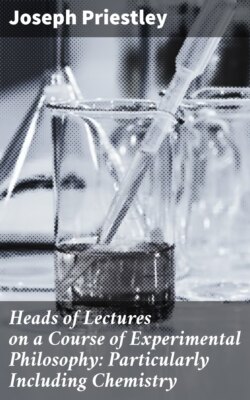Читать книгу Heads of Lectures on a Course of Experimental Philosophy: Particularly Including Chemistry - Joseph Priestley - Страница 16
Of Nitrous Air.
ОглавлениеNitrous air is procured by dissolving most of the metals, especially iron, mercury, and copper, in the nitrous acid; but that from mercury seems to be the purest. Nitrous air produced from copper contains a mixture of phlogisticated air. Some nitrous air is also obtained from the solution of all vegetable substances in nitrous acid; whereas animal substances in the same process yield chiefly phlogisticated air: but in both these cases there is a mixture of fixed air.
This species of air is likewise produced by impregnating water with nitrous vapour. This process continues to have this effect after the water becomes blue, but ceases when it turns green; there not then, probably, being a sufficient proportion of water. Nitrous air is likewise produced by volatile alkali passing over red hot manganese, or green vitriol, when they are yielding dephlogisticated air. This shews that dephlogisticated air is one ingredient in the composition of nitrous air, and the same thing appears by pyrophorus burning in it. On the contrary, when nitrous air is made to pass over red-hot iron, volatile alkali is produced.
Nitrous air is completely decomposed by a mixture of about half its bulk of dephlogisticated air, and the produce is nitrous acid. And as nitrous acid is likewise formed by the union of inflammable and dephlogisticated air, one principal ingredient in nitrous air must be common to it and inflammable air, or phlogiston. This air is likewise decomposed by dephlogisticated nitrous acid, which by this means becomes phlogisticated. It is also decomposed by a solution of green vitriol, which by this means becomes black, and when exposed to the air, or heated, emits nitrous air, and recovers its former colour. These decompositions of nitrous air seem to be effected by depriving it of phlogiston, and thereby reducing it to the phlogisticated air originally contained in it.
This kind of air is diminished to about one fourth of its bulk by a mixture of iron filings and brimstone, or by heating iron in it, or calcining other metals in it, when the remainder is phlogisticated air. All that iron gets in this process is an addition of weight, which appears to be water, but it loses its phlogiston, so that nitrous air seems to contain more phlogiston, and less water than phlogisticated air.
Nitrous air and dephlogisticated air will act upon one another through a bladder, but in this case there remains about one-fourth of the bulk of nitrous air, and that is phlogisticated air; so that in this case there seems to be a conversion of nitrous air into phlogisticated air without any addition of phlogiston.
Nitrous air is decomposed by pyrophorus, and by agitation in olive oil, which becomes coagulated by the process. It is also absorbed by spirit of turpentine, by ether, by spirit of wine, and alkaline liquors.
It is imbibed by charcoal, and both that air which is afterwards expelled from it by heat, and that which remains unabsorbed, is phlogisticated air.
Nitrous air resists putrefaction, but is diminished by the animal substances exposed to it to about a fourth of its bulk, and becomes phlogisticated air. It is likewise fatal to plants, and particularly to insects.
When nitrous air is long exposed to iron, it is diminished and brought into a state in which a candle will burn in it, though no animal can breathe it. But this peculiar modification of nitrous air, called dephlogisticated nitrous air, is produced with the greatest certainty by dissolving iron in spirit of nitre saturated with copper, impregnating water with this air, and then expelling it from the water by heat. If bits of earthen ware be heated in this dephlogisticated nitrous air, a great proportion of it becomes permanent air, not miscible with water, and nearly as pure as common air, so that the principle of heat seems to be wanting to constitute it permanent air.
